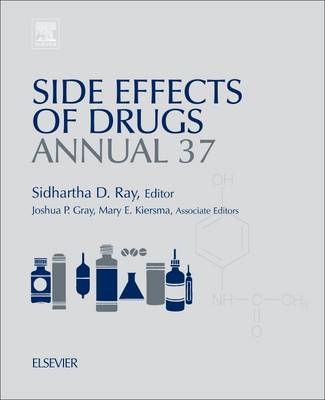
Side Effects of Drugs Annual
Elsevier Science Ltd (Verlag)
978-0-444-63407-8 (ISBN)
Sidhartha D. Ray, PhD, FACN serves as a Senior Professor of Pharmaceutical and Biomedical Sciences at The Touro College of Pharmacy at Manhattan, New York. Prior to this he served as Professor of Pharmaceutical Sciences for nearly 2 decades at the Arnold & Marie Schwartz College of Pharmacy and Health Sciences of Long Island University, New York, and as the founding chair of Pharmaceutical Science department at Manchester University College of Pharmacy, Indiana, USA. He has been in the health sciences academy for over 35 years mainly focusing on pharmacy teaching, research and service. Dr. Ray's research program focus on drug & chemical induced organ toxicology, mechanistic & molecular toxicology, adverse drug reaction mechanisms, side effects of a number of therapeutically relevant drugs and environmentally significant chemicals. Over the last two decades, Dr. Ray’s seminal discoveries have provided clear understandings on the dynamic role of apoptosis, necrosis and necraptosis during organotoxic reactions and have influenced the development of safety measures for a stunning variety of xenobiotics, phytochemicals and nutraceuticals. He is internationally recognized as a leader in the scientific community and was one of the front runners in exploring mechanisms of drug and chemical-induced programmed and un-programmed cell death in in-vivo models. His landmark studies on the interplay of bcl-2, bcl-xl, p53, bad and bax during acetaminophen induced cell death and its prevention by grape seed proanthocyanidin extract has earned worldwide citations. His peer recognition and acknowledged service contributions are reflected by his election into multiple international professional organizations, such as the Society of Toxicology (SOT), Society of Free Radical Biology & Medicine (SFRBM), American Society of Pharmacology & Experimental Therapeutics (ASPET), American Association of Colleges of Pharmacy (AACP) and American College of Nutrition (ACN). Dr. Ray is an Associate Editor of Encyclopedia of Toxicology (3rd Ed, Elsevier, 2014), and serves on the editorial boards of multiple prestigious international journals, including ‘Archives of Toxicology’ and ‘Oxidative Medicine & Cellular Longevity’. Based on his contributions to teaching, service and scholarship to health sciences in general, Dr. Ray received multiple prestigious awards, inc. the American Academy of Clinical Toxicology’s national research award (1996), ‘Fellow of the American College of Nutrition’ honor in 1999, David Newton Award for Excellence in Teaching Pharmacy (2005), the Biennial Abraham Krasnoff Memorial Award for Lifetime Scholarly Achievement (2008), Arnold & Marie Schwartz College of Pharmacy & Health Science’s ‘Wall-of-Fame’ honor (2011), the Society of Toxicology’s ‘Undergraduate Educator of the Year’ national award (2013), and the Manchester University’s ‘Outstanding Scholar of the Year’ award (2014). He currently serves on the SOT-NIH–NLM’s joint Toxlearn Project, SOT Undergraduate Task Force (2007 – present), and has previously served on the SOT’s Education Committee (2007 – 2010). In his lifetime, Dr. Ray has mentored research to numerous PharmD, MS, MD and PhD students in a number of areas of toxicology and biomedical sciences, made seminal contributions to the fields of pharmacology, toxicology, free radical biology, anticancer mechanism, phytochemicals, nutraceuticals & dietary supplements, and molecular safety sciences. Dr. Ray loves to promote ‘Lifelong Learning’ strategies to his students and clearly models his beliefs day in and day out. Visit URL: www.sidhartharay.com/ for more details.
1. Central nervous system stimulants and drugs that suppress appetite
2. Antidepressant drugs, 3. Lithium, 4. Drugs of abuse
5. Hypnotics and sedatives, 6. Antipsychotic Drugs, 7. Antiepileptic Drugs
8. Opioid analgesics and narcotic antagonists
9. Anti-inflammatory and antipyretic analgesics and drugs used in gout
10. General anesthetics and therapeutic gases
11. Local anesthetics
12. Neuromuscular blocking agents and skeletal muscle relaxants
13. Drugs that affect autonomic functions or the extrapyramidal system
14. Dermatological drugs, topical agents and cosmetics
15. Antihistamines (H1-receptor antagonists)
16. Drugs acting on the respiratory tract
17. Positive inotropic drugs and drugs used in dysrhythmias
18. Beta-adrenoceptor antagonists and antianginal drugs
19. Drugs acting on the cerebral and peripheral circulations
20. Antihypertensive Drugs, 21. Diuretics, 22. Metals
23. Metal antagonists
24. Antiseptic drugs and disinfectant
25. Penicillins, cephalosporins, other beta-lactam antibiotics, and tetracyclines
26. Miscellaneous antibacterial drugs
27. Antifungal Drugs, 28. Antiprotozoal Drugs, 29. Antiviral drugs
30. Drugs used in tuberculosis and leprosy
31. Antihelminthic drugs, 32. Vaccines
33. Blood, blood components, plasma and plasma products
34. Formulations used in nutrition
35. Drugs affecting blood coagulation, fibrinolysis, and hemostasis
36. Gastrointestinal Drugs
37. Drugs that act on the immune system: cytokines and monoclonal antibodies
38. Drugs that act on the immune system: immunosuppressive and immunostimulatory drugs
39. Corticotrophins, corticosteroids, and prostaglandins
40. Sex hormones and related compounds, including hormonal contraceptives
41. Thyroid hormones, iodine, and antithyroid drugs
42. Insulin, other hypoglycemic drugs, and glucagon
43. Miscellaneous hormones, 44. Drugs that affect lipid metabolism
45. Cytostatic Drugs, 46. Radiological contrast agents
47. Drugs used in ocular treatment
48. Treatments used in complementary and alternative medicine
49. Miscellaneous drugs and materials, medical devices and techniques
| Erscheint lt. Verlag | 11.12.2014 |
|---|---|
| Reihe/Serie | Side Effects of Drugs Annual |
| Verlagsort | Oxford |
| Sprache | englisch |
| Maße | 216 x 276 mm |
| Gewicht | 5700 g |
| Themenwelt | Schulbuch / Wörterbuch ► Lexikon / Chroniken |
| Medizin / Pharmazie ► Medizinische Fachgebiete ► Pharmakologie / Pharmakotherapie | |
| ISBN-10 | 0-444-63407-X / 044463407X |
| ISBN-13 | 978-0-444-63407-8 / 9780444634078 |
| Zustand | Neuware |
| Haben Sie eine Frage zum Produkt? |
aus dem Bereich


